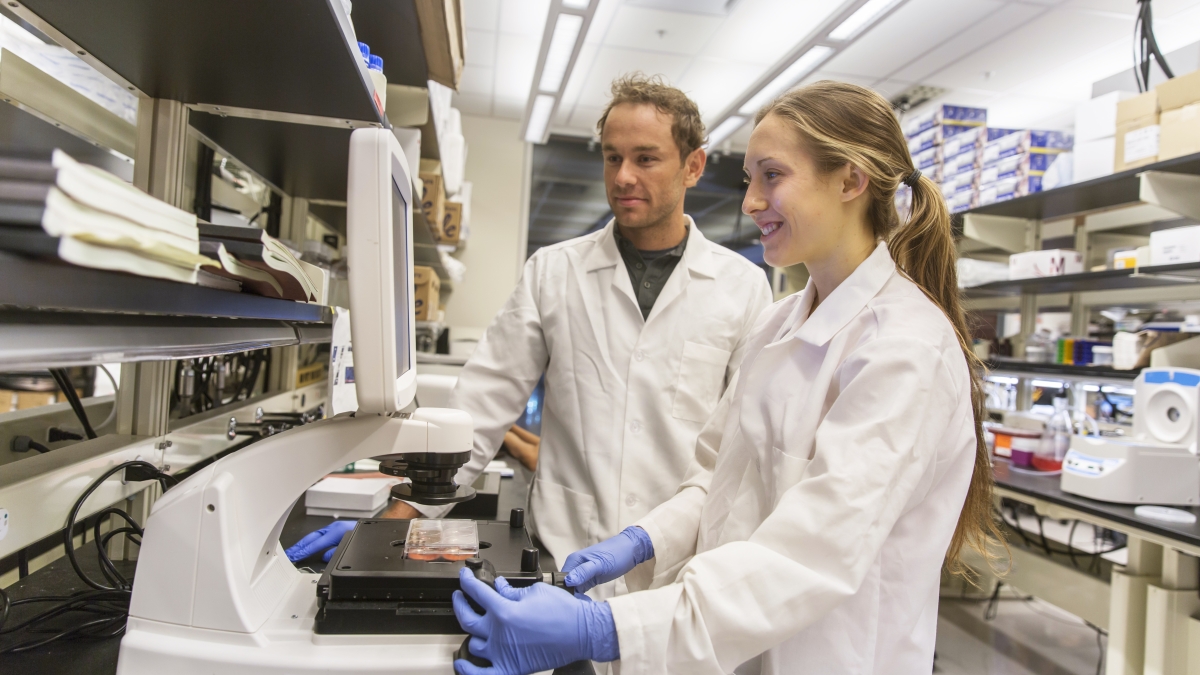From labs to lives: Self-replicating cells help treat neuro disorders

Assistant professor David Brafman mentoring biomedical engineering junior Lexi Bounds, who plans to pursue a career in stem cell research. Photographer: Jessica Hochreiter/ASU
Scientists estimate that human bodies contain anywhere from 75 to 100 trillion cells. And of these cells, there are hundreds of different types.
Yet, one cell type in particular has captured the fascination of assistant professor David Brafman: the human pluripotent stem cell (hPSC).
As self-replicating cells — capable of dividing and forming new cells — hPSCs offer immense research potential.
They are able to provide the raw material needed to generate the hundreds of different cell types that comprise the human body.
Think of it as a reverse e pluribus unum. Something like out of one, come many.
Brafman has received a $420,000 grant from the National Institutes of Health to take discoveries related to hPSCs out of the research lab and into the clinical setting where they can transform, even save, lives.
In particular, his research focuses on using the remarkable qualities of hPSCs to generate large quantities of hPSC-derived neurons, which are instrumental in advances toward the study and treatment of Alzheimer’s disease, ALS, spinal cord injuries and other neurodegenerative disorders.
“Neurodegenerative diseases and disorders remain some of the leading causes of mortality and morbidity in the United States,” said Brafman, a biomedical engineering faculty member in ASU’s Ira A. Fulton Schools of Engineering.
According to the Alzheimer’s Association, the disease affects more than 130,000 individuals statewide and is the fifth leading cause of death in Arizona.
“Several bottlenecks limit the translation of hPSCs and their derivatives from bench to bedside,” said Brafman, referring to the need to take this research from the laboratory bench to the clinical bedside.
For one, it requires billions of cells for research in disease modeling, drug screening, and cell-based therapies to be successful. So far, a rapid and comprehensive generation of these cells hasn’t been possible, and Brafman’s research aims to usher in the large-scale expansion of hPSC-derived neurons needed for these treatments and research applications.
“If successful, this work will provide researchers robust methods to generate the large quantities of cells needed for clinical applications,” Brafman said.
This NIH funding builds upon previous seed grant funding support from the Arizona Alzheimer’s Consortium, the Mayo Clinic and ASU.
“The funding provided by seed grant opportunities allowed us to acquire the preliminary data necessary to be competitive for these larger NIH grants,” Brafman said.
Brafman also has earned funding from the California Institute of Regenerative Medicine and the National Science Foundation.
Enhancing stem cell research at ASU
In addition to his NIH funding, earlier this year Brafman earned a grant from the ASU Women and Philanthropy Association for his work in establishing the ASU Stem Cell Training and Research (STaR) program.
“The use of stem cell-based technologies to treat devastating diseases requires a strong stem cell engineering program that will train young scientists with specialized knowledge and skills,” Brafman explained.
Beginning this summer, Brafman is building a comprehensive training program for stem cell engineers, paving the way for ASU and Arizona to become world leaders in the development of stem cell-based technologies and therapies.
Ten students in STaR’s first cohort completed their laboratory-based training courses and have begun their research internships in a diverse set of ASU laboratories.
“Dr. Brafman has brought a unique and much needed expertise to ASU in stem cell engineering,” said Marco Santello, director of the School of Biological and Health Systems Engineering, one of the Ira A. Fulton Schools of Engineering.
Santello said Brafman’s expertise allows his research program to “attract top students and build interdisciplinary collaborations within ASU and several clinical institutions in the Phoenix area.”
Before joining ASU in 2015, Brafman was the Kaehr Stem Cell Young Investigator at the Sanford Consortium for Regenerative Medicine at the University of California San Diego. He was also a Burnham Family Foundation Fellow at the Rady School of Management, where he earned his MBA in 2013.
Brafman’s work has been featured in many acclaimed journals such as Cell Reports, Cell Death and Differentiation, proceedings of the National Academy of Sciences and Stem Cell Reports.
His laboratory brings together dozens of graduate and undergraduate students from the School of Biological and Health Systems Engineering, the School of Life Sciences and the School of Molecular Sciences.
“Stem cell engineering spans a broad spectrum of research disciplines from developmental biology to more traditional engineering areas such as materials science. At ASU, we are really fortunate to have students that have interests and training in these various areas,” Brafman said.
More Science and technology

Cosmic clues: Metal-poor regions unveil potential method for galaxy growth
For decades, astronomers have analyzed data from space and ground telescopes to learn more about galaxies in the universe.…

Indigenous geneticists build unprecedented research community at ASU
When Krystal Tsosie (Diné) was an undergraduate at Arizona State University, there were no Indigenous faculty she could look to…

Pioneering professor of cultural evolution pens essays for leading academic journals
When Robert Boyd wrote his 1985 book “Culture and the Evolutionary Process,” cultural evolution was not considered a true…